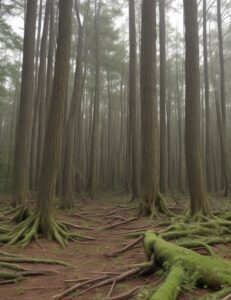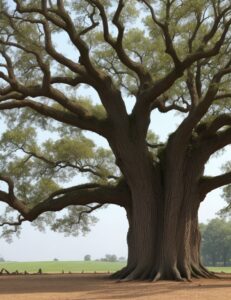Forests are susceptible to diseases and pests that can disrupt their balance and health. Forests, with their intricate web of life, are home to various microorganisms and pathogens. These include fungi, bacteria, viruses, and nematodes, which can cause diseases in trees and plants.
Dutch Elm Disease
DED is a notorious and devastating fungal disease that has left its mark on forests, parks, and urban landscapes, particularly in North America and Europe. It affects elm trees, causing wilting and eventually death.
 The primary culprit behind Dutch Elm Disease is a fungus known as Ophiostoma ulmi. This invader spreads its spores through bark beetles, tiny insects that unwittingly carry the pathogen from one tree to another as they feed and reproduce. The fungus then infiltrates the tree’s water-conducting vessels, known as xylem, disrupting the flow of water and nutrients.
The primary culprit behind Dutch Elm Disease is a fungus known as Ophiostoma ulmi. This invader spreads its spores through bark beetles, tiny insects that unwittingly carry the pathogen from one tree to another as they feed and reproduce. The fungus then infiltrates the tree’s water-conducting vessels, known as xylem, disrupting the flow of water and nutrients.
Identifying Dutch Elm Disease early is crucial for containment. Here are some key signs to look for:
One of the most noticeable signs is the sudden wilting of leaves on one or more branches, often during the summer months when elms should be in full leaf. The leaves on affected branches turn yellow and then brown, with the progression of symptoms moving toward the tips of the branches.
Dark, irregular cankers on the bark’s surface, often with a rough texture, can be indicative of DED infection.
In late spring or early summer, the fungus may produce tiny, pinkish-brown structures on the bark, resembling small mats.
Here are some strategies to protect your elm trees:
Promptly remove and destroy infected branches to prevent the fungus from spreading further. Manage bark beetle populations through insecticides or traps to reduce their role in spreading the disease.
If you need to prune or cut elm trees, ensure your tools are properly sterilized between cuts to prevent contamination.
Consider planting DED-resistant elm species or cultivars, as they have a better chance of surviving in infected areas.
Fungicide injections can be administered by professionals to protect healthy elms in high-risk areas.
Chestnut Blight
A fungal pathogen called Cryphonectria parasitica causes this disease, which decimated the American chestnut population in the early 20th century. The American chestnut tree (Castanea dentata) was once the pride of eastern forests, but today, it is critically endangered due to the devastating impact of Chestnut Blight.
Cryphonectria parasitica was accidentally introduced to North America in the early 20th century, most likely through imported Asian chestnut trees, which are resistant to the disease. This introduced pathogen found the American chestnuts vulnerable and began its relentless assault on these once-majestic trees.
Detecting Chestnut Blight in its early stages is crucial for any chance of containment. Here are some key symptoms to watch for:
Chestnut Blight causes cankers on the bark of infected trees. These cankers are often sunken, reddish-brown, and surrounded by a callus ridge. Infected branches and stems begin to wilt, wither, and die. This dieback often starts in the upper canopy and works its way down the tree.
In the late spring or early summer, the fungus produces tiny, orange to reddish-brown fruiting bodies called pustules. These pustules ooze spores, which can further infect healthy trees.
The fight to save the American chestnut from extinction continues through a combination of scientific research and public engagement:
Scientists are working tirelessly on breeding programs to create chestnut trees with a mix of American and blight-resistant genes, ultimately aiming to reintroduce a disease-resistant chestnut into the wild.
Raising awareness about Chestnut Blight and its devastating effects can lead to more support for conservation efforts and better forest management practices.
Pine Wilt Disease
PWD is an ailment that poses a significant risk to pine trees worldwide. This invader has wrought havoc on pine forests, and understanding its origins. The primary culprit responsible for Pine Wilt Disease is a microscopic nematode called Bursaphelenchus xylophilus. This tiny worm-like organism finds its way into pine trees through the activities of pine sawyer beetles. Once inside the tree, it disrupts the tree’s water-conducting system, causing wilting, dieback, and eventual death.
Early detection of Pine Wilt Disease is key to managing its impact effectively. Here are some common symptoms to watch out for:
Infected pine trees often display a distinctive browning of needles, starting at the top and progressing downward. As the disease takes hold, branches or sections of the tree may wilt, die, and turn brown. Look for the oozing of resin from cracks or wounds in the bark, especially near the base of the tree.
The presence of pine sawyer beetles, known carriers of the nematode, can indicate a potential infection.
Mitigating the impact of Pine Wilt Disease requires a multi-pronged approach:
Enforce strict regulations to control the movement of pine wood, lumber, and pine straw from infected areas to uninfected regions. Establish monitoring programs to swiftly detect outbreaks and assess the extent of infection.
Promote the cultivation of pine species that demonstrate resistance to Pine Wilt Disease. Employ strategies to manage pine sawyer beetle populations, including the use of targeted insecticides and traps.
Remove and safely dispose of infected trees to prevent further nematode spread.
Sudden Oak Death
SOD is a plant disease that has sent ripples through oak-dominated ecosystems, particularly in California and Oregon. It is primarily caused by an oomycete pathogen named Phytophthora ramorum. Unlike traditional fungi, oomycetes belong to a different group of microorganisms, sharing some characteristics with both fungi and algae. This pathogen thrives in wet, humid environments and infects a wide range of plants, with oaks being particularly susceptible.
 Detecting Sudden Oak Death is vital for preventing its spread and minimizing its impact. Here are some key symptoms to look out for:
Detecting Sudden Oak Death is vital for preventing its spread and minimizing its impact. Here are some key symptoms to look out for:
Early in the disease’s progression, leaves of infected oak trees may display brown or black lesions. These lesions often appear as irregularly shaped spots and can cause leaf dieback. As the disease advances, you might notice dark, sunken cankers on the tree’s trunk and branches. These cankers can ooze a dark, reddish-brown sap.
The pathogen can also infect acorns and young shoots, causing them to shrivel and die prematurely.
Some oak species exhibit bleeding cankers, where a dark, reddish-brown liquid seeps from the cankered areas, giving rise to the name “bleeding canker.”
Efforts to mitigate the impact of Sudden Oak Death are multifaceted and often require a combination of approaches:
Implement strict regulations on plant movement to contain the spread of the pathogen. Promote biosecurity practices to prevent the accidental transfer of the pathogen from one area to another.
In heavily affected areas, selective logging may be employed to remove infected trees while preserving healthy ones.
Invest in ongoing research to better understand the disease and establish monitoring programs to detect outbreaks early. Educate the public on the importance of responsible plant transportation and avoiding high-risk activities during the wet season.